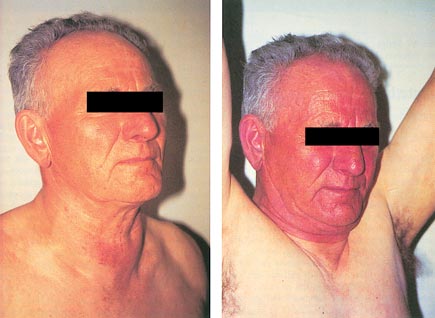MKSAP Quiz: Painless neck swelling
A 65-year-old man is evaluated because of painless neck swelling and difficulty swallowing that has progressively worsened over the last year. He does not have hoarseness, but he feels as though his voice is not as strong as it was in the past. Medical history is significant for multiple thyroid nodules. Fine-needle aspiration of three of the largest nodules 5 years ago showed that all nodules were benign on cytologic examination. Medical history is otherwise unremarkable, and he takes no medications.
On physical examination, vital signs are normal. The thyroid is diffusely enlarged and mobile with swallowing. He has facial flushing when raising his hands above his head as shown.

No cervical lymphadenopathy is noted. Cardiovascular and pulmonary examinations are normal. Reflexes are normal, and there is no visible tremor.
Laboratory studies show a serum thyroid-stimulating hormone (TSH) level of 4.0 µU/mL (4.0 mU/L).
Thyroid ultrasound shows innumerable coalescent nodules with no suspicious sonographic features. There is diffuse enlargement of the thyroid, and the inferior edge of the gland cannot be visualized. CT scan shows substernal extension of the goiter in the left lobe with mild tracheal narrowing and tracheal deviation to the right.
Which of the following is the most appropriate treatment?
A. External-beam radiotherapy
B. Levothyroxine
C. Radioactive iodine
D. Thyroidectomy
Answer and critique
The correct answer is D: Thyroidectomy. This question can be found in MKSAP 17 in the Endocrinology & Metabolism section, item 72.
This patient should undergo thyroidectomy to treat his obstructive substernal goiter and prevent further airway compromise, which may be rapid and fatal. The thyroid nodule biopsy findings obtained 5 years ago most likely represent adenomatous hyperplasia, and the sonographic features of the gland and slow progression of the compressive symptoms support a diagnosis of a benign lesion. He has evidence of compressive symptoms on physical examination, with facial flushing when raising his arms (Pemberton sign). The flushing indicates venous outflow obstruction by the goiter as the vessels course through the thoracic inlet. Additionally, his symptoms of dysphagia and change in voice quality may suggest a compressive effect on the esophagus and recurrent laryngeal nerves, respectively. Surgical removal of the thyroid offers the best option for immediate relief of symptoms and identification of a possible underlying malignancy.
External-beam radiotherapy can result in eventual shrinkage of the thyroid but will not provide immediate relief of his obstructive symptoms, is unlikely to be curative, potentially increases the risk of secondary malignancy, and is associated with significant morbidity.
Levothyroxine therapy has been shown to reduce thyroid volume by up to 20%, but the clinical significance of this small change in volume with such a large goiter is unlikely to improve symptoms. Additionally, levothyroxine therapy may take many months to years to reduce the thyroid volume, and this patient needs immediate relief of his obstructive symptoms.
Radioactive iodine has been used to shrink multinodular goiters; the volume change is also gradual and optimal reduction averages 40%. However, radioactive iodine therapy may be risky in this patient because acute swelling of the thyroid after iodine uptake can lead to compromise of the vascular structures at the level of the thoracic inlet and further compression of the trachea.
Key Point
- In patients with multinodular goiter with compressive features, thyroidectomy is most likely to provide immediate relief of symptoms, decrease the risk of fatal airway compromise, and possibly identify underlying malignancy.





